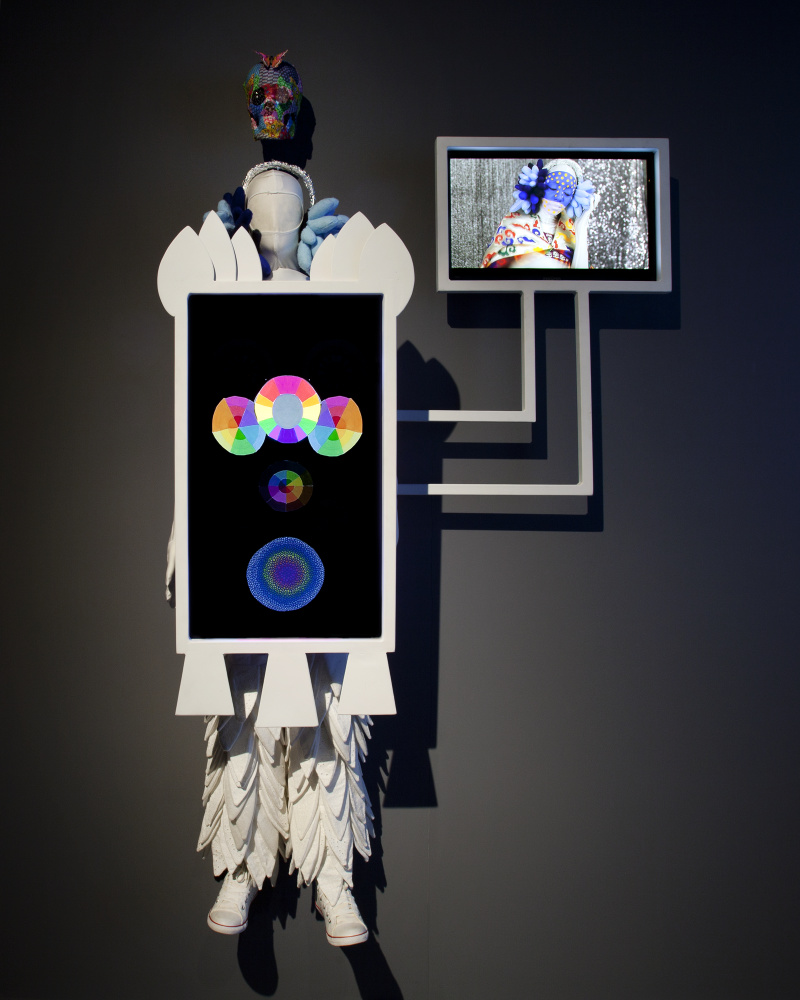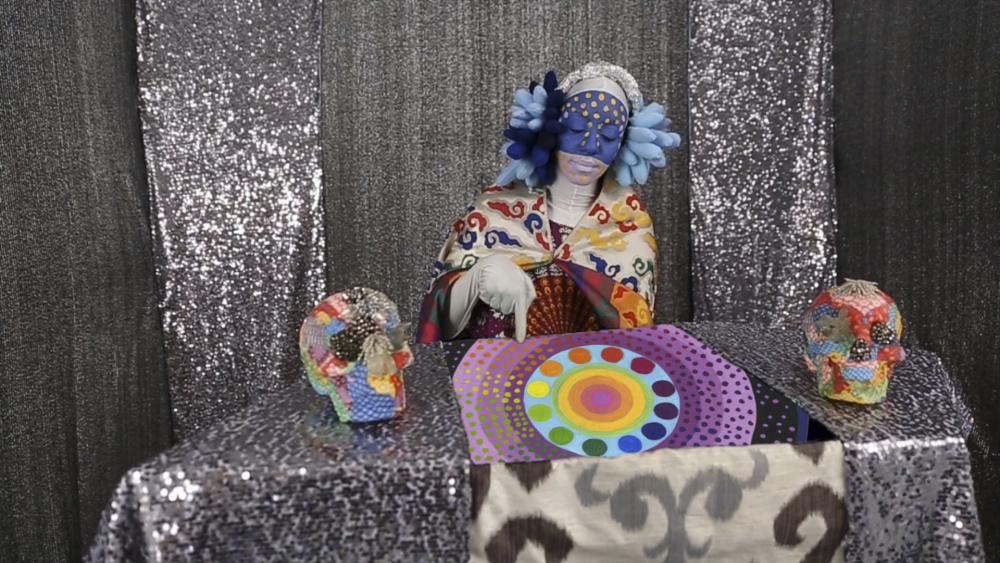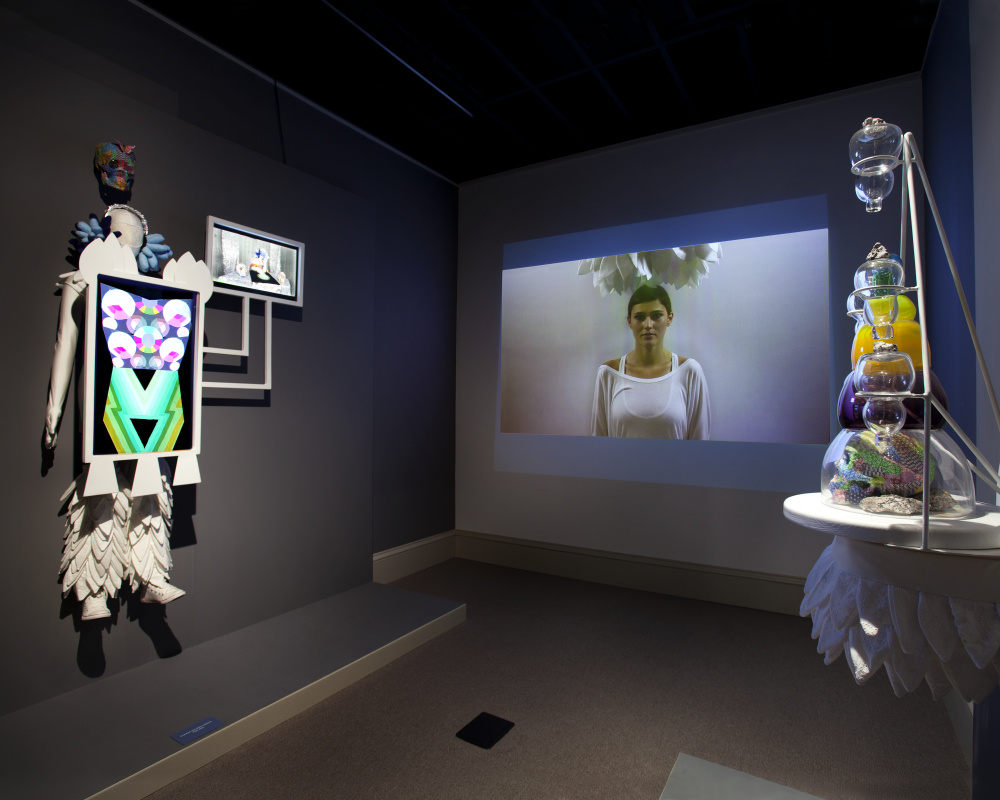- Open today, 10 am to 5 pm.
- Parking & Directions
- Free Admission
Object of the Week: Hybridization Machine

Saya Woolfalk’s Hybridization Machine immerses viewers in a world of their own making. The mixed-media work was inspired by many pertinent contemporary sociopolitical issues. An extreme example of a futuristic hybrid species with cloned humans and hallucinogenic vision, the work highlights how human bodies are constantly being manipulated by surgery for physical development, aesthetics, and power. Technology intersects with utopian dreams of race and ethnicity, allowing visitors to explore the nature of humanity and push the boundaries of their imaginations.
In the early-to-mid 2000s, Woolfalk created the Empathics—a fictional race of women who transformed into plant-human hybrids after coming in contact with a fungus growing near the bones of an unusual being. In the artist’s fictional world, the women created the nonprofit Institute of Empathy to study interspecies hybridization. They also worked to increase worldwide compassion by sharing their ability to absorb the qualities of surrounding life forms.

Saya Woolfalk (American, b. Japan, 1979), Video still from ChimaTEK: Hybridization Machine, 2013
The Empathic’s narrative later shifted as they established the for-profit corporation ChimaTEK to market their discoveries. With the change in the Empathic’s business model, viewers are now learning how they can market their identity without losing their utopian ideals.
The Chrysler introduced visitors to the Empathics in fall 2014 with ChimaTEK Life Products. Woolfalk’s second solo exhibition, the show featured the high-tech Hybridization Machine designed to allow consumers to have their minds and bodies remixed at home by a virtual DJ. It appeared alongside a mock video advertisement for ChimaTEK’s Life Products line and a Combustion Chamber for the mysterious fuel to facilitate human conversions. The Combustion Chamber was created to Woolfalk’s specifications by the Chrysler’s Perry Glass Studio team.

Saya Woolfalk (b. 1979), Life Products by ChimaTEK, 2014. Video, color, sound, 3:17 min., 16:9. Whitney Museum of American Art, New York; purchase with funds from the Film, Video, and New Media Committee 2017.176. © Saya Woolfalk

Saya Woolfalk ChimaTEK, In The Box, 2014.
Woolfalk has spent the past twenty years making humanoid hybrids incorporating video, craft, and installation. The New York-based artist often creates a multi-sensory experience that invites people into a miniature world to see the Empathics and watch anthropological videos of their discoveries and philosophies. Figures such as Hybridization Machine are hung from walls in rooms painted to resemble a sky or forest setting. The artist references the legacy of life-size dioramas prevalent in natural history museums, but her artworks are of a futuristic world where humans are blended into new beings.
When looking at the figure in the Hybridization Machine video, the viewer cannot determine ethnicity or gender. Woolfalk considers “a blended of raciality” because of her own mixed-race background.[i] The artist of Japanese, Caucasian, and African American heritage brings her own multiplicity into her creations. Yet the Empathics have evolved even further. They are a combination of human and plant, a synchronization of humanity and the world around us. For the artist, this future hybrid could be the ultimate utopian future.

Third Thursday at the Museum, with Saya Woolfalk and DJ Spooky. November 20, 2014. Photo by Eleise Theurer.
Hybridization Machine is a particularly interesting work to consider now that we’ve witnessed a global pandemic. As humans battle against the environment, we wonder if we will ever be completely harmonious with it. Social distancing measures meant to help prevent the spread of coronavirus came with recommendations to spend time outside, plant gardens, and be grateful for the environment. What would it mean if humans truly became a part of the ground beneath their feet?
Following Woolfalk’s exhibition at the Chrysler, the Museum added Hybridization Machine to the growing collection of sculptural works, craft-related objects, and works by women and artists of color. When the Museum reopens, stop by gallery 225 to see the work for yourself and consider it from a new perspective based on your own experiences.
–Kimberli Gant, PhD, McKinnon Curator of Modern & Contemporary Art
Saya Woolfalk (American, b. Japan, 1979)
Hybridization Machine, 2013
Mannequin, fabric, steel sculpture, video monitors, and video
Metal fabricated by Jay Roth; musical score by DJ Spooky, That Subliminal Kid; videography by Rachel Lears; acting by Duhirwe Rushemeza; animation by Nicholas Tuinstra; editing by Tyler Henry; and consulting by Ron Eglash
Museum purchase with funds provided by Meredith & Brother Rutter and Joseph T. Waldo, 2015.1
[i] Nicole Fleetwood, “Performing Empathies: The Art of Saya Woolfalk,” Callaloo 37, no. 4 (2014): 979.

